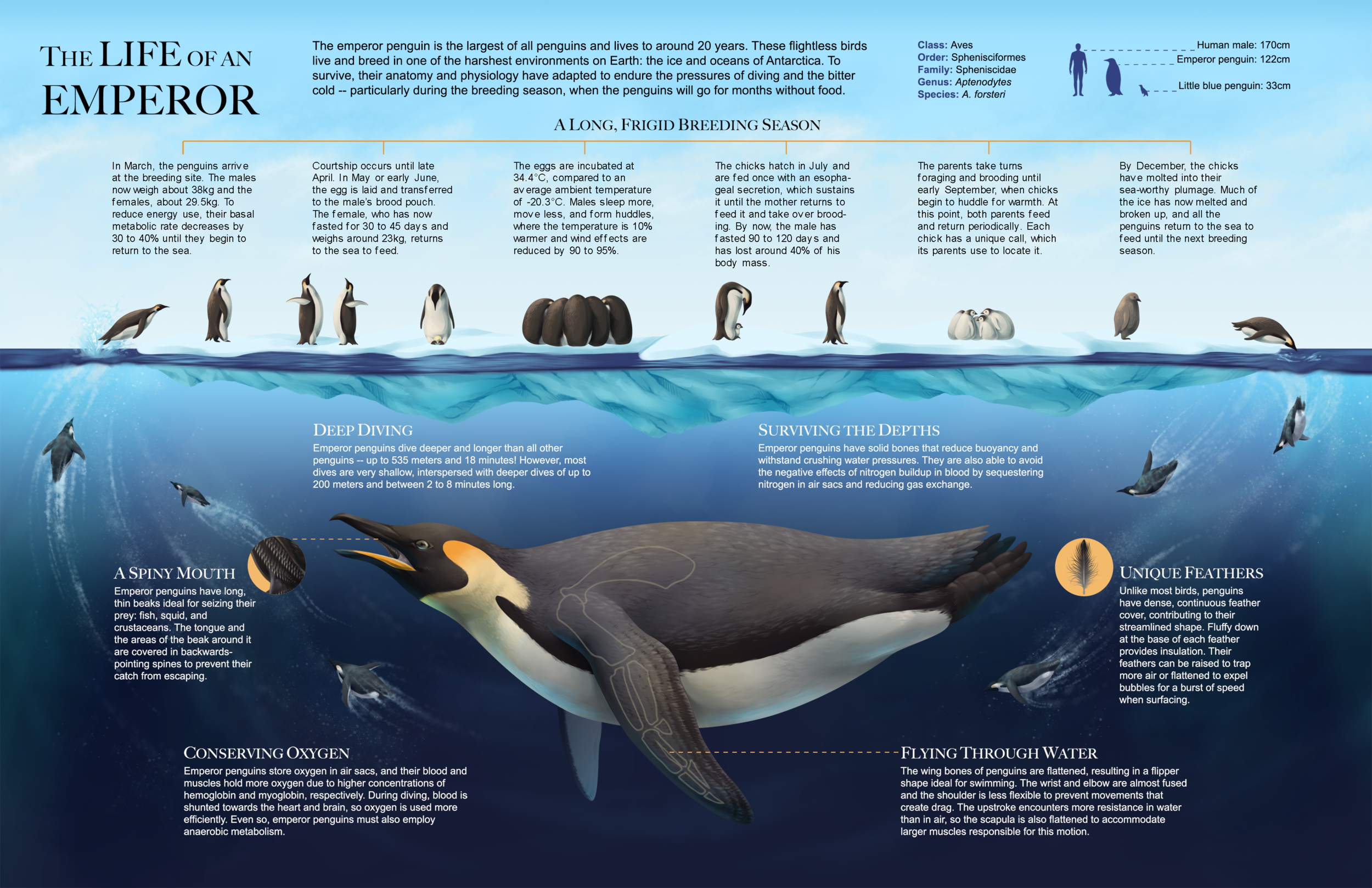Client: Professor Jodie Jenkinson
Year: 2020
Media: Adobe Illustrator, Adobe Photoshop
Emperor penguins live and breed in Antarctica, one of the most inhospitable environments on Earth. This infographic is intended to teach a lay audience about how emperor penguins are adapted for swimming, diving, and surviving in a cold climate. It is also intended to teach the audience about emperor penguins’ unique behaviours during the breeding season, which include fasting and traveling long distances.
Featured in the 2020 Association of Medical Illustrators Online Salon and the 2024 Guild of Natural Science Illustrators Juried Member’s Exhibit.
Process Work
Research and Thumbnails
First, I conducted research on emperor penguins to determine what I wanted to include in my infographic. Their two most unique aspects are their behaviours during breeding season and their adaptations for deep diving, so I decided to include a timeline on an ice floe and a diving penguin underneath. I chose the second thumbnail as the circular layout would guide the eye around the infographic.
Text and Layout
I started by laying out the text so I knew how much space would be available for graphics. After sketching the components, I moved the text and images around until I was satisfied with the layout.
Flat Colours
At this point, the text and layout were practically finalized. I used Adobe Illustrator to create the main shapes and flat colours.
Rendering
Here, I began to render the images in Adobe Photoshop. I added clouds to subtly visually separate the title and introductory paragraph from the timeline and added shading to the penguins. I also added icons and leader lines to the appropriate text blocks.
Finished Infographic
I finished rendering the penguins by adding highlights, as well as blue backlight to the diving penguin. To add motion and guide the eye, I added streams of bubbles behind the swimming penguins in the background.
References
Academic Sources
Groscolas, René. (1990). Metabolic Adaptations to Fasting in Emperor and King Penguins. In Davis, Lloyd S. and Darby, John T. (Eds.), Penguin Biology (pp 269-293). California: Academic Press.
Kooyman, Gerald L., and Ponganis, Paul J. (1990). Behavior and Physiology of Diving in Emperor and King Penguins. In Davis, Lloyd S., and Darby, John T (Eds.), Penguin Biology (pp 229-242). California: Academic Press.
Müller-Schwarze, Dietland. (1984). The Behavior of Penguins: Adapted to Ice and Tropics. New York: State University of New York Press.
Stonehouse, Bernard (Ed.). (1975.) The Biology of Penguins. London: MacMillan Press Ltd.
Williams, Tony D. (1995). Bird Families of the World: The Penguins: Spheniscidae. Oxford, England: Oxford University Press.
Visual References
Bauernfeind, Emily. 2017. “Preen My Back and I’ll Preen Yours!” New England Aquarium. Accessed March 4, 2020. https://www.neaq.org/blog/preen-back-ill-preen/
BBC Earth. 2018. “Emperor Penguins Fight Over Mate | BBC Earth.” BBC Studios. Accessed February 23, 2020. https://www.youtube.com/watch?v=UREUvuS2MsA
BBC Earth. 2018. “Emperor Penguins Mourns Over the Death of Chick | BBC Earth.” BBC Studios. Accessed February 23, 2020. https://www.youtube.com/watch?v=Yrv5VlMJPfI
BBC Earth. 2014. “How does a penguin launch itself from the sea? - The Wonder of Animals | BBC.” Accessed February 23, 2020. https://www.youtube.com/watch?v=snAvGxz7D04
Flood, Sue. 2008. “Emperor penguin Aptenodytes forsteri, close up view of adult. Snow Hill Island rookery, Antarctica.” Alamy. Accessed February 12, 2020. https://www.alamy.com/stock-photo-emperor-penguin-aptenodytes-forsteri-close-up-view-of-adult-snow-hill-27139368.html
Ksepka, Dan. 2010. “Tour of the Penguin Skeleton I: Scapula.” March of the Fossil Penguins. Accessed February 5, 2020. https://fossilpenguins.wordpress.com/2010/09/23/tour-of-the-penguin-skeleton-i-scapula/
Ksepka, Dan. 2012. “Tour of the Penguin Skeleton: The Phalanges.” March of the Fossil Penguins. Accessed February 5, 2020. https://fossilpenguins.wordpress.com/2012/06/13/tour-of-the-penguin-skeleton-the-phalanges/
Lunau, Claus. “Emperor penguin skeleton, illustration.” Science Photo Library. Accessed February 12, 2020. https://www.sciencephoto.com/media/1032878/view/emperor-penguin-skeleton-illustration
Mayntz, Melissa. (2019). A Penguin Does Have Wings, But They Are Called Flippers. The Spruce. Accessed February 5, 2020. https://www.thespruce.com/flipper-definition-penguin-wings-385251
Stone, Emily. (n.d.). Emperor penguins diving under ice – Aptenodytes forsteri. National Science Foundation. Accessed February 10, 2020. https://www.coolantarctica.com/gallery/penguins/emperor_penguin_7.php
Yong, Ed. (2015). Busting Myths About Penguin Feathers. National Geographic. Accessed February 5, 2020. https://www.nationalgeographic.com/science/phenomena/2015/10/20/busting-myths-about-penguin-feathers/






